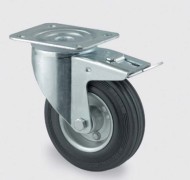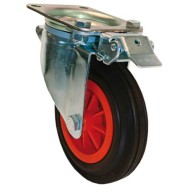 It’s the age old problem! There is something heavy to move at work, it’s got to be relocated, so do you stop and think about it or just get on with the job?
It’s the age old problem! There is something heavy to move at work, it’s got to be relocated, so do you stop and think about it or just get on with the job?
Nearly 1/3rd of all injuries reported are from a direct result of incorrect manual handling (HSE) requiring days off work and costing the economy millions!
To avoid injuries when pushing or pulling wheeled transport, take time to assess the situation and specify the right castors for the job. This may then save you time, money and your back!
Top tips to avoid Manual Handling Injuries
• Consider using handling aids to improve manoeuvrability.
• Ensure the appropriate castor or wheels are specified as this has an impact on ease of movement.
• Take into account floor surface, as an uneven floor requires higher forces to move the load. This will increase the load bearing requirements on each castor and wheel.
Get the Right Castors
 Getting the right castor can have a dramatic impact in reducing manual handling injuries.
Getting the right castor can have a dramatic impact in reducing manual handling injuries.
Equally ‘over-specifying’ a castor may be unnecessarily costly. The following guidance should help to get the specification right
1. Load capacity
As a general ‘rule of thumb’, the load capacity for the castor should be one third of the sum of the trolley weight and the maximum load it has to carry.
2. Swivel or fixed?
Swivel castors rotate to improve manoeuvrability and can be equipped with a brake to lock the wheel and swivel movement. To help control the movement of the trolley we recommend a combination of fixed and swiveling castors depending upon your application
3. Fittings
Castors are available with a wide variety of fittings. The choice of fitting is largely a question of the frame to which the castor must be fitted.
4. Wheels and tyres
In most cases, the larger the wheel, the higher its load capacity and the easier it is to move. Different wheel and tyre materials are available to suit various floor surfaces.
5. Bearings
There are four types of bearings to help reduce rolling resistance: plain bore with no bearings (for light loads moved over short distances); roller bearings (for easy movement of heavy loads); ball journals (for lower friction and a longer working life for heavy loads and constant movement); and tapered roller bearings (for the best performance and higher load capacities).
 To find out more about specifying castors and wheels, and to obtain information on the latest technologies within the castor and wheel industry, call Ross Handling Ltd or visit their website technical support page http://www.rosshandling.co.uk/ technical-support.asp
To find out more about specifying castors and wheels, and to obtain information on the latest technologies within the castor and wheel industry, call Ross Handling Ltd or visit their website technical support page http://www.rosshandling.co.uk/ technical-support.asp




Comments are closed.